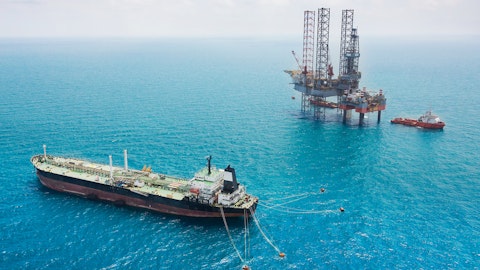Ecopetrol S.A. (NYSE:EC) Q4 2023 Earnings Call Transcript March 1, 2024
Ecopetrol S.A. isn’t one of the 30 most popular stocks among hedge funds at the end of the third quarter (see the details here).
Operator: Good morning. My name is Natalia, and I will be your operator today. Welcome to Ecopetrol’s Earnings Conference Call, in which we will discuss the main financial and operational results for the fourth quarter and year-end 2023. There will be a questions-and-answer session at the end of the presentation. Before we begin, it is important to mention that the comments in this call by Ecopetrol’s senior management include projections of the company’s future performance. These projections do not constitute any commitment as to future results, nor do they take into account risks or uncertainties that could materialize. As a result, Ecopetrol assumes no responsibility in the event that future results are different from the projections shared on this conference call.
The call will be led by Mr. Ricardo Roa, CEO of Ecopetrol; Alberto Consuegra, COO; David Riano, Vice President of Low Emission Solutions; and Milena Lopez, CFO. Thank you for your attention. Mr. Roa, you may begin your conference.

Ricardo Roa: Good morning, everyone. With regards to the 2023 results call, a year of significant achievements [Technical Difficulty] by goals and progress in energy transition projects. We will have marked numerous operational records and value generation, overcoming a more challenging market environment. In 2023, we strengthened the traditional hydrocarbon business across all its segments. In 2023, we are strengthened the traditional hydrocarbon business, across all its sectors. We closed the year with a production of 757,000 barrels of oil equivalent per day, a figure not seen in eight years supported by our fields in Colombia and the Permian subsidiary contributing 9% to the total produce. We transport 1,130,000 barrels per day with 306,000 barrels per day through pipelines, the highest in the group’s history.
In refining, we achieved an unprecedented financial performance with over [COP73.3 trillion] (ph) in EBITDA, the highest refining load in history of 120 barrels per day, [Technical Difficulty] continues to supply and operation of the Cartagena refinery plant interconnection, IPCC. We achieved an exploratory [Technical Difficulty] 50% above industry standard, highlighting milestone like Glaucus-1 announced earlier and Orca Norte-1, the first deepwater well 100% drilled by Ecopetrol which confirm the presence of two gas accumulations in reservoirs different from the Orca-1 discovery. This expands our offshore gas potential, referring our commitment to the countries and energy security. In the commercial front in October 2023, we announced the opening of the trading office in Houston to be closer to global markets and attain better results.
This is ongoing effort to diversify customers and markets who currently sell more than 50% of our crude oil stores to the Asian market. In Transmission, Roads and Telecommunications segment, secured contracts in 2023, representing investment of COP10 trillion for the coming years. Let’s move to the next slide. We made significant progress in the commitment to decarbonization and to consolidate energy transition projects, achieving a cumulative reduction of green house gas emission up nearly 1.5 million tons of CO2 equivalent by the end of the year, aligning with the path to net zero emission [Technical Difficulty] of this emission relate to methane where Ecopetrol standard its emission to achieve zero methane emission initiative of the Oil and Gas Climate Initiative.
See also 25 Countries with the Strongest Armies in the World and Top 25 Oil Exporting Countries in the World in 2024.
Q&A Session
Follow Ecopetrol S A (NYSE:EC)
Follow Ecopetrol S A (NYSE:EC)
The commitment to action on climate change is evident, showcased by our adherence to the global sector agreement to accelerate the decarbonization of oil and gas during COP28 alongside 49 other oil companies. In 2023, we reused 152 million cubic meters of water, abiding, capturing and discharging this volume, representing 79% of the total water required for operations. This achievement was recognized by CDP Water Security, giving us and A minus leadership rating for outstanding water management practices, making us one of the best companies in the oil and gas sector in these practices. In addition, in 2023, Ecopetrol was certified by ICONTEC in the calculation of water footprint in [eight] (ph) production fields and the two refineries, being the only oil and gas company in Latin America that have reached this achievement.
Ecopetrol Group reported an energy saving of 3.89 petajoules at the end of 2023, the highest figure since 2018 when maturing began and 250% higher than that presented in 2022. Moreover, we added 472 megawatts of renewable energy to optimize our energy metrics and decarbonize our operations. In terms of sustainability, we invest COP1.9 trillion in the social dimension, we allocate COP520 million to education, public services and regional economic diversification, making a 17% increase from 2022. We promote the energy transition by expanding the coverage of social gas service through networks benefiting more than 20,000 new homes in Colombia with physical connections. Regarding our human talent, it’s noteworthy that we successfully negotiated the 2023-2026 collective labor convention with nine labor organizations.
Also, we highlight our recognition in 2023 Merco ranking as the Colombian company with the greatest capacity to attract and retain talent. We also emphasize low accident levels with a total recordable injury frequency of 0.26 injuries per million hours worked. We rank among to the top high global oil and gas companies in this aspect, according to the International Association of Oil and Gas Producers’ data for 2023. Let’s move to the next slide. We highlight the commitment to the country with historical transfer to the nation in 2023 represented in [COP23 trillion] (ph) dividends, COP26 trillion in taxes and COP10 trillion in royalties. Additionally, in 2023, Ecopetrol Group allocated resource for the execution of the sustainable territorial development portfolio worth COP594 billion, which includes social, strategical and mandatory environmental investments.
Through this investment, Ecopetrol Group contributed to the economic and social development of the country, implementing projects with local authorities and the community alongside national partners and international cooperation to generate well-being and contributed to closing social gaps. Key social investment milestone of Ecopetrol during the year include 150,203 students benefited from projects and programs aimed at improving the quality, increasing its overall retention and expanding coverage in higher education. 8,670 entrepreneurs, SMEs and youth benefit from programs for capacity development in entrepreneurship and innovation. With 15,019 people with improved access to clean water, 197.93 kilometers of roads network intervened contributing to dynamics of regions, weather terrestrial mobility and local job creation.
I want to thank the firm commitment of all our workers, allies and communities where we operate, who with their dedication, make Ecopetrol the leading force in transforming Colombia’s energy. Let’s move to the next slide. This result demonstrates that the roadmap outlined in the strategy affirmed in September 2023 during the celebration of Ecopetrol’s 15 years of the New York Stock Exchange is clear and guides our stalwart to define purpose. 2023, we attained the second best result in the history of the Ecopetrol Group, surpassing the previous year when the average Brent price approached $100 per barrel. In 2023, crude price dropped to $82 per barrel, combined with inflationary pressures and high energy costs, creating a very challenging environment for the company cost structure.
However, we exceptionally overcame this, generating revenues of COP143.1 trillion, equivalent to 9% of the national GDP, an EBITDA of COP60.7 trillion and net profit of COP19.1 trillion. The profit was impacted by a 10% in contracts such as an impairment that reduced the net income by COP0.9 trillion for the period. We closed the year with the highest record of transfers to the Nation in Ecopetrol’s history, COP58 trillion. Also, I emphasized that we ended the year with an account receivable from the Fuel Price Stabilization Fund with an accumulation 44% lower than 2022, leaving cash pressures and highlighting the active management of the Ecopetrol teams as well as the commitment of the nation has allowed us the highest execution level of 97% of the investment plan with the highest level in the last eight years equivalent to COP27 trillion.
It is worth mentioning that as a result of these dynamics, as well as the market environment, Ecopetrol generated a total local return for its shareholders of 26% for the year and 46% for ADR investors, which adds to the confidence shown by the market in our issues and ratings. With this excellent result, we prepare for a challenging 2024 not only in terms of international prices and inflation, but also the impact of the El Nino phenomenon and the balance of the natural gas market. We will face these challenges by strengthening our operating capacity in the traditional business with the highest safety standards, maintaining capital discipline and with a clear focus on competitive returns. I will give the floor to Alberto Consuegra, who will talk in more detail about the 2023 operating performance.
Go ahead, Alberto.
Alberto Consuegra: Thank you, Ricardo. By year-end 2023, the net proven reserves of the Ecopetrol Group amounted 1,883 million barrels of oil equivalent, maintaining average levels of the last nine years even under challenging market conditions. Proved developed reserves increased by 4% versus 2022, showing an improvement in our CapEx execution. Organically, 307 million barrels of oil equivalent were incorporated, but at the same time, 188 million barrels of oil equivalent were debooked, mainly impacted by external factors associated with the lower Brent price, inflationary effects as well as decline in water breakthrough in gas fields such as Ballena, Cupiagua and Recetor for a net incorporation of 119 million barrels of oil equivalent.
Going forward, the main future sources of reserve additions are concentrated in fields such as Castilla, Rubiales, Cano Sur, CPO 09, Cira Infantas, Piedmonte, development of Colombian Caribbean gas discoveries and tertiary recovery in heavy oil fields. Contingent gas resources grew 79% as compared to 2022 from 1.9 to 3.4 tera cubic feet, leveraged mainly on the Uchuva and Gorgon offshore developments. Let’s move on to the next slide, please. In 2023, Ecopetrol and its partners drilled 23 exploratory wells, in line with the plan. Three wells built in 2022 were declared successful in 2023, totaling 11 last year, with an estimated potential between 100 million and 150 million barrels of oil equivalent of resources, of which 70% is gas. Regarding offshore exploration, I would like to highlight the exploratory success of Glaucos-1 in the coal-fired block operated by Shell, which confirmed the presence of a gas reservoir.
The Orca Norte-1 well drilled in 2023 and completed in 2024 confirmed two gas accumulations in reservoirs different from the Orca-1 discovery, triggering a reevaluation of the regional project while expanding the gas potential of La Guajira Offshore. Orca Norte-1 was the first deepwater well operated 100% by Ecopetrol SA, which was completed without any operational incidents and with the highest industry standards. The appraisal campaign of the Uchuva discovery located in the Tayrona block, starting with the Uchuva-2 well to be spotted in the second quarter of 2024. On the onshore front, I would highlight the following. Appraisal of the frontier between the Castilla and Chichimene fields in block CPO 09 as a result of the Magnus and Kimera-1 discoveries in partnership with Repsol.
And the Arauca 8 well drilled in 2023, which was completed in 2024, confirmed the presence of light crude in a new reservoir, extending the potential of the Arauca field in the channels basin. Let’s move on to the next slide, please. As Ricardo mentioned, in 2023, the Ecopetrol Group reached a production of 737,000 barrels of oil equivalent per day, increasing by 27,000 barrels of oil equivalent per day when compared to 2022. I would like to highlight the startup of the first fluid treatment train at Cano Sur field, bringing field production to 41,000 barrels of oil in December 2023, as well as Permian’s incremental production and increased water management capacity in the Rubiales field. The aforementioned enabled an incremental production of 70,000 barrels of oil equivalent per day, an 18% increase versus 2022.
By year-end, fields with secondary and enhanced recovery programs contributed nearly 41% of Ecopetrol Group’s daily production. It is worth highlighting the greater execution capacity in the facilities front supported by the construction initiation of [indiscernible] station at CPO 09 and the commissioning of the fluid expansion of the Centauros station at Cano Sur and the water management facilities at Rubiales. The growth in production was achieved in a sustainable manner by reducing 486,000 tons of CO2 equivalent, 84% of the total emission reduction of the Ecopetrol Group. These results were leveraged by energy efficiency initiatives, elimination of venting and methane lakes, reduction of flaring and incorporation of renewable energy into the operation.
In 2024, we expect production between 725,000 and 730,000 barrels of oil equivalent per day, driven mainly by drilling campaigns at Rubiales, Cano Sur and Permian, the continuation of secondary recovery projects with water injection in heavy oil fields and the production coming from new gas projects in Piedmonte. These target volumes incorporate challenges that are being managed, such as El Nino phenomenon, security and social unrest situations and ongoing environmental permits. Let’s go to the next slide, please. With regards to our activities in the Permian Basin, 120 new wells were drilled in 2023 for a total of 318 wells on production since 2019, reaching a production of 66,400 barrels of oil equivalent per day for Ecopetrol before royalties, which represent 9% of the group’s production.
We also highlight the strong financial results of Ecopetrol Permian. By year-end, we achieved an EBITDA of $799 million and an EBITDA margin of 88%. In addition, the following achievements of the Ecopetrol-Oxy Association are noteworthy. After four years, the association achieved a record in production of 163,000 barrels of oil equivalent per day before royalties in early December, of which 103,000 barrels of oil equivalent per day belongs to Ecopetrol, recording drilling and completion of a well with the longest lateral length of 18,000 feet. In line with our TESG strategy, we highlight the progress in the decarbonization of our Permian operation with a low emission intensity of 7 to 8 kilograms of CO2 per barrel of oil equivalent. Likewise, the association is committed to the reduction of diesel consumption and managed to replace an average of 36% of the diesel used in drilling and completion operations by compressed natural gas, CNG.
For 2024, the association is expected to drill more than 110 wells, and Ecopetrol expects an average production between 80,000 and 83,000 barrels of oil equivalent per day before royalties. Next slide, please. Transported volumes increased by more than 42,000 barrels per day in 2023, primarily due to an increase in crude oil transportation, thanks to higher production, particularly in the Llanos region. In 2023, we achieved significant milestones, including a historical record in refined product evacuation of 306,000 barrels per day, leveraged mainly by increased product availability at both refineries and operational optimizations in transportation systems. In oil pipelines, we reached a record with dilution of Rubiales crude at the Monterrey station.
A total of 163,000 barrels of Nafta were received and around 858,000 barrels of Rubiales crude were diluted, achieving a quality of 21.2 degrees API crude. This leverages the midstream strategy to become an integrated logistics service provider. We ensure the evacuation of oil from the Cano Limon field, thanks to the execution of 13 reversal cycles of the Bicentenario pipeline. The segment maintained a carbon-neutral operation certified by ICONTEC since 2022 and achieved a reduction of over 15,000 tons of CO2 emissions. Lastly, we highlight the segment’s financial results, generating revenues of nearly COP16 trillion and an EBITDA of COP11.8 trillion, contributing with 19% of the Ecopetrol Group’s EBITDA. With regards to regulation, on December 20, 2023, the Ministry of Mines and Energy issued Resolution 40745, which regulated the activity of transportation by multiphase pipeline.
This regulatory framework allows the midstream segment to continue evaluating projects that would increase transport levels and use of current infrastructure. Let’s move on to the next slide, please. In the downstream segment, we achieved outstanding financial and operational results with historical records in refining throughput and operational availability, thanks to the rigorous execution of scheduled major maintenance activities, operational efficiencies as well as a favorable pricing scenario. This resulted in an EBITDA of COP7.3 trillion, the second highest in the segment’s history. In 4Q 2023, the combined refining throughput reached 429,000 barrels per day, 84,000 barrels per day higher than in the same period of previous year. The integrated refining gross margin was $13.1 per barrel, mainly affected by weaker diesel jet and gasoline spreads.
In 2023, we accomplished multiple milestones, of which we highlight this. Operational availability of refining plants above 95% and the highest in the last five years. Successful execution of the pyrolytic oil test from post-consumer plastic waste at the Barrancabermeja refinery, enabling the production of around 19 tons of polypropylene in Esenttia, contributing to the Ecopetrol Group’s circular economy strategy. 95% progress in the construction of the mechanical recycling plant in Esenttia, which is expected to start operations during the first quarter of 2024. Finally, Ecodiesel received an ICONTEC carbon-neutral certification, becoming the first biodiesel company in Colombia to receive this certification. Let’s move on to the next slide, please.
In 2023, the Ecopetrol Group managed to incorporate efficiencies of COP4.5 trillion, leveraging outstanding operational performance and partially mitigating inflationary pressures, increases in energy costs, which combined with greater operating activity, raised the cost structure of our operations and investments. The total unit cost reached $47.6 per barrel, largely due to the effect of lower prices on crude and product purchases and imports. The incorporation of efficiencies of $0.68 per barrel allowed to partially offset the aforementioned effects. The lifting costs increased by 18.45%, reaching $10.91 per barrel, mainly impacted by external factors such as El Nino phenomena, inflationary effects and the exchange rate, representing a $1.41 per barrel increase in 2023.
However, the efficiency plan mitigated the increase in lifting costs by $0.33 per barrel. Likewise, the cost per barrel transported and the refining cash cost increased by 8.8% and 1.6%, respectively, mainly due to inflationary effects and higher activity in both segments. This year, we continue to focus on incorporating efficiencies to maintain business competitiveness and sustainability. Now, I will turn it over to David Riano, who will discuss the main milestones of the Low Emission Solutions business line.
David Riano: Thanks, Alberto. Our Low Emission Solution business continues to move forward on the road of decarbonization, energy security and contribution to society. In 2023, we highlight the outstanding performance of our energy efficiency program, which between 2018 and 2023 achieved an optimization of the energy demand of 10.9 petajoules. This is equivalent to COP262 billion in savings with an impact of approximately 708,000 tons of CO2 equivalent. Only in 2023, we achieved a reduction of 3.9 petajoules and 274,000 tons of CO2 equivalent in our operations, thanks to the incorporation of new technologies for energy optimization. These are the best results since the beginning of the measurement in 2018, 250% higher than those reported in 2022.
And in orders of magnitude, it’s an optimization similar to the annual consumption of all households in the Colombia cities of Cartagena, Ibague and Cucuta. In alignment with our commitment to decarbonization of our operations, we ended 2023 with the incorporation to our energy metrics of 472 megawatts in operation, construction and execution of nonconventional renewable energy sources. The operation of renewable energy sources in 2023 allowed us to reduce close to 19,000 tons of CO2 equivalent and capture savings of more than COP28 billion. The above restate our goals within the framework of our strategy of incorporating 900 megawatts by 2025, growing with sustainability and generating value for our stakeholders. On the social front, we highlight two important initiatives with positive impact on the welfare of the community.
The social gas program, we so far in 2023, connected to the natural gas service, more than 20,000 families in rural areas of Arauca, Guajira and Atlantico and the successful completion of the micro LNG agreement in Buenaventura, giving support and reliability to the gas supply for 37,000 families in this area of the country. During 2023, gas and LPG production reached 162,000 barrels equivalent per day, representing 22% of the group’s production mix, 75% of the country market share and approximately COP3.5 trillion EBITDA. 2023 reaffirms our commitment to the energy transition, prioritizing the country’s energy security, while holding firm in the search of opportunities to meet our objectives. Now I will pass the floor to Milena Lopez, who will tell us about the main results of the Transmission, Roads and Telecommunications segment.
Over to you, Milena.
Milena Lopez: Thank you, David. The Transmission and Roads business generated positive operational and financial results, accompanied by significant awards throughout 2023, which will translate into investments of COP9.8 trillion in the coming years, reinforcing our subsidiaries’ growth trajectory across various geographies. In 2023, we sustained a growing trend in financial outcomes, with revenues reaching COP14.2 trillion and an EBITDA of COP9.1 trillion, representing nearly 6% growth in these two areas compared to 2022. Net profit attributable to Ecopetrol remained relatively stable at COP675 billion. As of the close of 2023, is achieved a committed investment balance of approximately COP30 trillion for the coming years, approximately 93% of the total of these investments correspond to bids and tenders that have been awarded to the company.
Among the most notable milestones for the fourth quarter are the following. In Peru, the award to ISA in consortium with the Grupo Energia de Bogota for the construction, operation and maintenance of two projects encompassing over 1,000 kilometers of electrical transmission grids, and with a referential CapEx of approximately COP3.2 trillion. In Chile, ISA Intervial was awarded the Southern Orbital Santiago concession for the design, construction and operation of 25 kilometers of a new urban highway. This project will have a reference CapEx of approximately COP1.9 trillion. In Brazil, the award through ISA CTEEP of 40 enhancements, which collectively will amount to a CapEx of around COP181 billion. The commencement of operations for the following projects, Guayepo Solar Park connection in Colombia, electrical interconnection, Itaunas and Triangulo Mineiro by ISA CTEEP in Brazil, three substations and the approval of integration into the National Electrical System of the private project, Puerto Chancay in Peru.
ISA continues to progress in the construction of 34 energy transmission projects in countries where it operates, which upon completion, would add over 5,500 kilometers to the grid and generate approximately COP1.7 trillion in revenue between 2024 and 2030. Finally, progress continues in the execution of the Ruta del Loa project and works in the concessionaires, Ruta de la Araucania and Ruta de Los Rios in Chile, which will generate new income and extensions of the terms of these concessions. Please let’s move to the following slide. Our financial results reflect the excellent operating performance of the Ecopetrol Group, allowing us to achieve in 2023, the second best results in the company’s history. Throughout the year, we achieved financial results that exceeded the targets set forth in our financial plan with superior results across key indicators.
Our EBITDA margin reached 42%, with a return on average capital invested of 11.5%. We also achieved an EBITDA of COP60.7 trillion, with efficiency gains reaching COP4.5 trillion, representing a 25% annual growth. Our investment execution capacity reached its highest level in eight years, totaling approximately COP27 trillion, in line with our annual target. Of these investments, 63% were concentrated in Colombia, with the remaining 37% executed in the United States, Chile and Peru, among others. Approximately 70% of total investments were allocated to exploration and production activities in our primary assets such as Rubiales, Cano Sur and Castilla in Colombia as well as in Permian in the United States. This category also includes investments in natural gas totaling around COP3 trillion focused on assets like Florena and Cupiagua in the Piedemonte Janeiro and offshore blocks, Tayrona and Col-5.
Investments in the transportation and refining business accounted for a combined 13%, focusing on intervention, maintenance and asset reliability improvements supporting increased activity levels throughout the year. The transmission and toll road businesses represent 17% of the CapEx for Grupo Ecopetrol. These investments were prominently directed towards power transmission, which accounts for approximately 87% of the investments, advancing projects in electrical transmission in Colombia and reinforcements and network improvements in Brazil. Traditional business lines, including natural gas, contributed to approximately 85% of EBITDA in 2023. Additionally, our transmission and toll roads businesses made a significant contribution of 15%, contributing to the stability of the group’s income and operating cash.
The gross debt-to-EBITDA ratio stood at 1.7 times, aligned with our long-term guidance to remain below 2.5 times gross debt to EBITDA. As part of our financing strategy, we successfully issued a $1.85 billion bond in the international markets in January 2024. This bond was 3.2 times oversubscribed, confirming investment appetite for our paper. This issuance was accompanied by the repurchase of a bond maturing in 2025, reflecting a proactive debt management strategy of our future maturities. These operations allowed us to optimize short-term liquidity management while maintaining debt costs at competitive levels. For 2024 maturities, we’re in the process of renewing a committed line for $1.2 billion, and we’ll be covering the remaining amortizations with the resources from the aforementioned bond.
Let’s move on to the next slide, please. Regarding our liquidity position, the Ecopetrol Group closed 2023 with a robust cash position of COP14.3 trillion. Our operating cash flow was COP19.8 trillion, which ascends to COP41.4 trillion when including the fuel price stabilization fund compensation. Additionally, there were significant cash disbursements for CapEx, and the net movement of debt and interest totaled COP5.8 trillion. In terms of the fuel price stabilization fund, we ended 2023 with positive news. The outstanding balance from 2022 was fully settled through dividend payments to the Nation, totaling COP2.6 trillion and COP4.7 trillion that were received in cash. In addition, due to a gradual increase in gasoline prices in the country by approximately COP4,800 per gallon over 2023, we experienced a lower accumulation in the account receivable when compared to 2022, closing 2023 with a FEPC balance of COP20.5 trillion.
Regarding taxes. The effective tax rate for 2023 was 36.6% compared to 31.4% in 2022, mainly due to the windfall tax established by the recent tax reform. For the fourth quarter of 2023, two tax adjustments were made. The first one regarding the income tax provision in accordance to the Constitutional Court ruling in November of 2023 that enabled the tax deductibility of royalty payments. The second associated to the income tax surcharge, which ended the year at 10% due to the average price of Brent throughout 2023. Let’s move to the next slide, please. As part of the 2040 strategy, our investment plan for 2024 maintains high levels of investment, reflecting our commitment to the country’s energy security and transition. We expect to execute investments between COP23 trillion and COP27 trillion, with approximately 45% of these directed towards energy transition initiatives, including low emission solutions, natural gas supply, TESG investments, decarbonization, electric transmission and roads.
The remaining 55% will focus on energy security and long-term cash protection, in line with strengthening our traditional business. These investment levels allow us to plan for profitable production between 725,000 and 730,000 barrels per day, maintain transported volumes around 1 million barrels per day and throughput at our refineries between 420,000 and 430,000 barrels per day. Considering an average Brent price scenario of $75 per barrel for the year, we expect to maintain competitive returns with a return on average capital invested of around 9% and an EBITDA margin of 38% as well as transfers to the nation exceeding COP38 trillion. Furthermore, with a focus on cost control and mitigation, between 2024 and 2026, we will incorporate targets for commercial and operational efficiencies, expense control and austerity totaling over COP7 trillion.
I now hand over to Ricardo for closing remarks.
Ricardo Roa: We closed a challenging 2023 marked by lower oil prices and higher inflationary pressures. However, we achieved the group’s second best year ever with the tactical operational results in terms of producing in the throughput of the refinery in volumes transported through our pipeline system and progress on energy transition projects. Today, the Ecopetrol Group aspires to be the leader in energy diversification in Latin America, in line with our 2040 strategy, Energy That Transforms. I want to express special thanks to the subsidiaries of the Ecopetrol Group, which alongside us, have contributed to making history. I express my gratitude to Ecopetrol Permian, would contribute to the production with its exceptional performance as well as to semi connecting the entire country and achieving an unprecedented annual production evacuation of pipelines.
I thank the refineries for reaching a history load with the highest operational availability in the last five years. I also highlight the performance of Hocol, contributing to the 11 successful wells on the Ecopetrol Group during the year, reaffirmed our commitment to the preservation of the traditional business. In ISA, I highlight the transition awards worth COP10 trillion that we will see in the coming years as well as its contribution to the EBITDA of the business growth. We remain committed to generate value for our shareholders, investors and our country and those countries where we have a presence, always maintaining responsible and sustainability operations that accelerate steps towards the energy transition. Thank you all for your participation.
With this, we open the question-and-answer session.
Operator: Thank you very much. We’ll start with our Q&A session. Ricardo Sandoval from Bancolombia is online with a question. Mr. Sandoval, you can ask.
Ricardo Sandoval: Good morning, everyone. Thank you for this space and for the explanations. If it is possible to know a little bit more information about the reservoirs, when you mentioned that the organic growth, I would like to know if you can tell me how much — was it because of better forecast, because of new project, because of extensions and findings? And for 180 million of barrels, how much was due to the price effect or in general by each of these items you mentioned in the report?
Alberto Consuegra: Good morning, Ricardo. Thank you for your question. It is Alberto Consuegra. Yes, we can give you the details. I’m going to start mentioning around the 307 million barrels. Let’s talk about that. So in the report, we are very clear about the impact of about the 31 million barrels. If you add the maturity process of the project, which is normal, in five years’ view, it’s 103 million barrels. Others that are associated to new findings is 2 million barrels and 109 million are related with better behavior of the production basic curve. That gives you 307 million. On the other hand, in terms of impact, when you talked about external effects, we’re talking about 58 million barrels, which — 30 million are associated with price and 28million with the inflation.
So what this does is that when we remove the cash flows of each field, the tail will be affected by the impact both of price as well as the inflation. And second, place due to conditions or technical revisions, 130 million barrels. The largest impact is in gas due to water and decline of our mature fields, particularly in Ballena, Cupiagua and Recetor. But besides that, we had around 30 million which are related with regular technical revisions in the plan in the Magdalena Medio and Villa.
Ricardo Sandoval: Thank you very much.
Operator: The next question is from Andres Duarte from Corficolombiana. Mr. Duarte, you can ask now. Andres Duarte, please, you can ask your question now.
Andres Duarte: Thank you. I have three questions. I think they’re short. The first one is please, can you explain how you can justify the impairment evolution in the downstream, considering that price differentials between the products of oil have annual and quarterly decreases? And annually, they have annual decreases. So I would like to understand why are you showing an improve of COP1.4 million there? And the other question is related with production. And congratulations — sorry for not saying this before, but congratulations for the production data of this quarter. The production that you show in the fourth quarter, it’s only overcome by the 2015 quarter — fourth quarter. But if you consider the permit from outside of Colombia, well, basically, without the increase in the Permian production that has — that we’ve had, this wouldn’t be a case.





